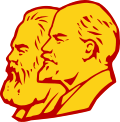Real socialism
 From Wikipedia - Reading time: 16 min
From Wikipedia - Reading time: 16 min
| Part of a series on |
| Marxism–Leninism |
|---|
 |
Real socialism, better known as actually existing socialism,[1] was an ideological catchphrase popularized during the Brezhnev era in the Eastern Bloc countries and the Soviet Union.[2]
The term referred to the Soviet-type economic planning implemented by the Eastern Bloc at that particular time.[2] From the 1960s onward, Communist states such as Poland, East Germany, Hungary, Czechoslovakia, and Yugoslavia began to argue that their policies represented what was realistically feasible given their level of productivity.
The concept of real socialism alluded to a highly developed socialist system in the future. The actual party claims of nomenclatory socialism began to acquire not only negative, but also sarcastic meanings. In later years and especially after the dissolution of the Soviet Union, the term began to be remembered as only one thing, i.e. as a reference for Soviet-style socialism.[note 1]

Definition
[edit]After World War II, the terms "real socialism" or "really existing socialism" gradually became the predominating euphemisms used as self-description of the Eastern Bloc states' political and economical systems and their society models.[3] De jure often referred to as "people's republics", these states were ruled by a communist party, some of which were ruled autocratically and had adapted a form of planned economy and propagated socialism and/or communism as their ideology.[3] The term "real (-ly existing) socialism" was introduced to explain the obvious gap between the propagated ideological framework and the political and economical reality faced by these states' societies.[3][4][5] As US Communist Party activist Irwin Silber put it in 1994,
The term 'actually existing socialism’ is not (despite the quotation marks) a sarcasm; in fact, while obviously containing an implicit irony, the phrase itself was coined by Soviet Marxist-Leninists and was widely used by the Communist Party of the Soviet Union (CPSU) and its supporters in polemics with those who postulated a model of socialism significantly different from the system developed in the Soviet Union. Its point was that various alternatives to the Soviet-derived model existed only in the minds of their advocates, while 'actual socialism' existed in the real world.[6]
The term was also taken up by some dissidents, such as Rudolf Bahro, who used it in a more critical way.[7][8]
See also
[edit]Notes
[edit]- ^ See definitions and descriptions of "real socialism" in the following:
- Kyu-Young Lee, "System Transformation in Poland since 1989: A view on the transformation of the real-socialist system. Including List of References. Graduate School of International Studies, Sogang University.
- Krzysztof Brzechczyn, The Collapse of Real Socialism in Eastern Europe. Adam Mickiewicz University, Department of Philosophy. The Journal of Interdisciplinary Studies in History and Archaeology. Vol. 1, No. 2, pp. 105–133
- Tittenbrun, Jacek (1993). The Collapse of 'Real Socialism' in Poland. Paul & Co Pub Consortium. ISBN 1-85756-043-4.
- Robert W. Cox, "Real socialism" in historical perspective. Pages 177–183. Retrieved November 3, 2011. See term: "actually existing socialism" in Rudolph Bahro's The Alternative in Eastern Europe, Note 3, p. 190.
References
[edit]Citations
[edit]- ^ Sebestyen, Victor (2010). Revolution 1989: The Fall of the Soviet Empire. Phoenix. ISBN 978-0-7538-2709-3.
- ^ a b "Socjalizm Realny" [Real Socialism]. Encyklopedia Interia (in Polish). Retrieved 22 November 2013.
- ^ a b c Hey, Patrizia (2010). Die sowjetische Polenpolitik Anfang der 1980er Jahre und die Verhängung des Kriegsrechts in der Volksrepublik Polen. Tatsächliche sowjetische Bedrohung oder erfolgreicher Bluff? [The Soviet policy towards Poland in the early 1980s and the imposition of martial law in the People's Republic of Poland. Actual Soviet threat or successful bluff?]. Studien zu Konflikt und Kooperation im Osten (in German). Vol. 19. Münster: LIT. p. 31. ISBN 9783643107718.
- ^ "A Guide To The Left". New Internationalist. 5 November 1985. Archived from the original on 22 September 2023. Retrieved 21 September 2021.
- ^ Lebowitz, Michael A. The Contradictions of "Real Socialism".
- ^ Silber, Irwin (1994). Socialism: What went wrong? (PDF). Pluto Press – via Marxists Internet Archive.
- ^ Bahro, Rudolf (November–December 1977). "The Alternative in Eastern Europe" (PDF). New Left Review (I/106): 3–37. Retrieved 21 September 2021.
Socialism as it actually exists, irrespective of its many achievements, is characterized by: the persistence of wage-labour, commodity production and money; the rationalization of the traditional division of labour; a cultivation of social inequalities that extends far beyond the range of money incomes; official corporations for the ordering and tutelage of the population; liquidation of the freedoms conquered by the masses in the bourgeois era, instead of the preservation and realization of these freedoms (only consider the all-embracing censorship, and the pronounced formality and factual unreality of so-called socialist democracy). It is also characterized by: a staff of functionaries, a standing army and police, which are all responsible only to those above them; the duplication of the unwieldy state machine into a state and a party apparatus; its isolation within national frontiers.
- ^ Frank, Pierre; Rosenzweig, Mark; Vale, Michel (1980). "Was". International Journal of Politics. 10 (2/3). Taylor & Francis, Ltd.: 152–167. ISSN 0012-8783. JSTOR 40470166. Retrieved 21 September 2021.
Sources
[edit]- General
- Real socialism from A Dictionary of Sociology, 1998, originally published by Oxford University Press.
 KSF
KSF